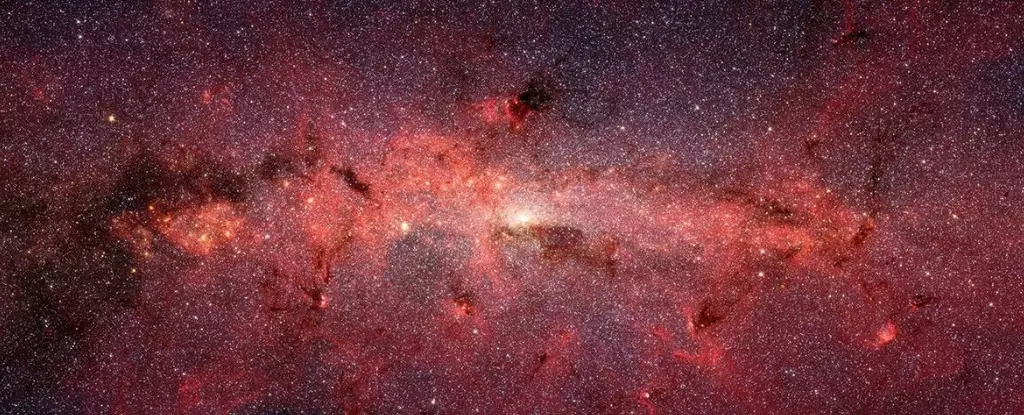For decades, the cosmic tapestries woven with threads of dark matter have haunted scientists, particularly in the heart of our very own Milky Way galaxy. The central molecular zone (CMZ)—a chaotic, dense region extending nearly 700 light years—stands as a beacon of intrigue, housing phenomena that challenge our understanding. High levels of ionisation in the CMZ highlight an unsettling reality: ordinary cosmic explanations, such as cosmic rays or stellar light, seem unable to account for the bizarre rates at which hydrogen molecules are being electrically charged. Compounding this mystery is the eerie glow of gamma rays at 511 kilo-electronvolts (keV), signaling a potential collision of electrons with their antimatter counterparts, positrons. Together, these observations point to a deeper, more sinister undercurrent in the very fabric of our universe.
The Dark Matter Hypothesis: A Lurking Giant?
Dark matter’s elusiveness has led scientists down a convoluted path of speculation, emerging as a key player in the cosmic drama unfolding within the CMZ. Comprising around 85% of the universe’s matter, dark matter remains entrenched in shadows, leaving behind gravitational clues but revealing nothing of its intrinsic nature. Among the theories contending for attention are light dark matter candidates, specifically those sub-GeV particles theorized to possess surprisingly minuscule masses. Although their existence is speculative, this subset of dark matter might offer the answers we’ve been seeking.
Could these light dark matter particles be the puppeteers behind the peculiar ionisation rates? Groundbreaking studies suggest that contacts within the dense milieu of the galactic center could generate chains of electron-positron interactions, resulting in rapid ionisation as these lightweight dark matter particles meet their antiparticles. Imagine the CMZ as a frenetic dance floor, where these particles collide and ignite a chain reaction reminiscent of a cosmic fireworks display.
Gamma Ray Revelations: Decrypting the Unexpected Glow
The 511 keV emissions are disconcertingly enigmatic. First identified in the 1970s, this gamma-ray signature has stumped researchers ever since. Candidates ranging from supernova remnants to black holes have been proposed, but none faithfully encapsulate the emission’s pattern or intensity. This lack of clarity hints at the complexity underlying cosmic behavior—an intricate dance often overshadowed by the simplicity we strive to impose through conventional models.
Emerging theories underscore a distinct yet striking possibility: that both ionisation and the gamma-ray glow derive from the annihilation of dark matter particles within the tight confines of the CMZ. By simulating how these sub-GeV particles annihilate, it’s now proposed that they could efficiently ionize their surroundings while simultaneously producing visible gamma rays. If these theorists are correct, the destruction of dark matter could be the very act producing both electrified hydrogen and scintillating gamma rays, thus presenting a unified theory that interlinks the two phenomena.
Implications for Future Research
The intersection of these phenomena offers profound implications for the future of cosmic research. A well-designed cohort of upcoming telescopes could begin to reveal the elusive connections between ionisation rates and gamma emissions. As researchers navigate the mysteries underpinning dark matter, the CMZ stands as a potent fortress of secrets begging for further exploration.
But the potential impact stretches beyond merely cataloging the cosmos—understanding dark matter’s role in the CMZ helps ground theoretical physics in tangible observations. Rather than pursuing errant theories in a vacuum, aligning dark matter with observable phenomena would mark a watershed moment in scientific inquiry. In an age where the boundaries of knowledge are continually expanded, one can only wonder about the implications if dark matter solidifies into a robust theoretical framework explaining cosmic behavior.
As we attempt to decrypt the perplexing signals emanating from the heart of our galaxy, we recognize the precarious balance between certainty and speculation in the realm of astrophysics. Through the changing galactic rhythm of the CMZ, each revelation unfurls like a cosmic flower, enticing scientists to untwist the ever-complex knot of the universe’s secrets. The tantalizing interplay between ionisation, gamma-ray emissions, and dark matter not only enriches our understanding of cosmic dynamics but also underscores the remarkable sentiment that the universe thrives on enigmas. With time, patience, and innovative research, we may unravel these mysteries, leading to an enlightening trajectory into the very core of existence.


Leave a Reply